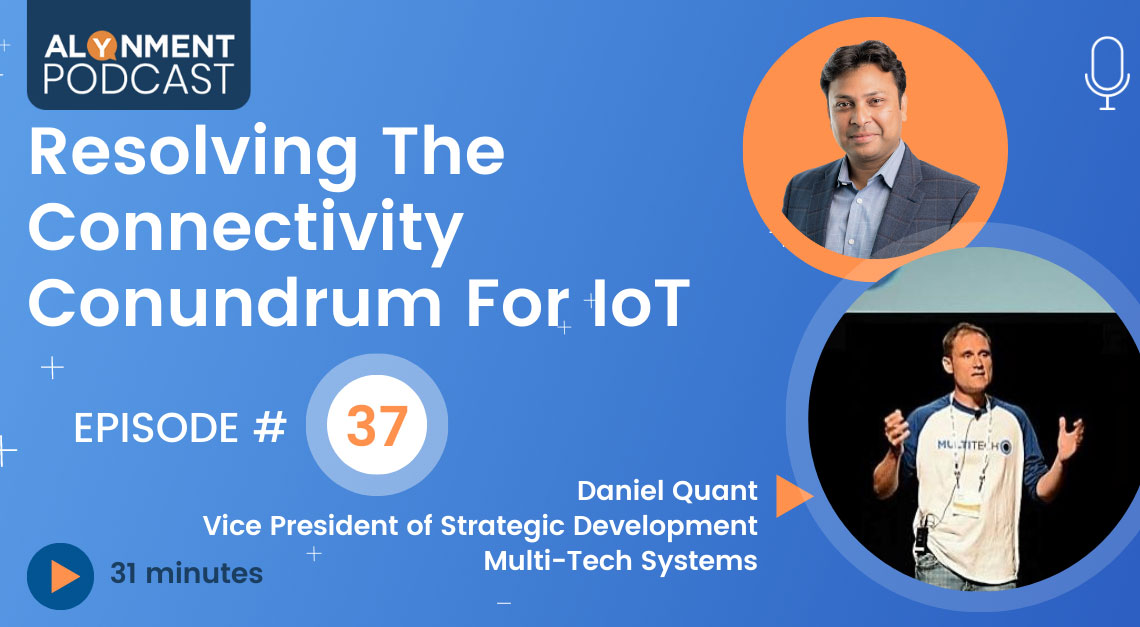
“Anything that can be connected, will be connected,” stated the technology pioneer, Kevin Ashton. And with the emergence of the Internet of Things (IoT), this statement has never been truer. The IoT has the potential to transform industries and revolutionize the way we live, work, and interact with the world around us. However, the connectivity requirements for these devices present a significant challenge, particularly in areas with limited infrastructure. The connectivity conundrum for IoT is a complex issue that requires innovative solutions. Are you tired of dealing with the connectivity conundrum of IoT?
In this podcast hosted by Ashish Jain, Chief Editor of PrivateLTEand5G, Daniel Quant, Vice President of Strategic Development at MultiTech Systems, explores the latest developments in IoT connectivity, from emerging protocols and standards to cutting-edge technologies that are revolutionizing the way we connect and communicate.
Challenges and Solutions
Before delving into the connectivity conundrum, it is important to understand the different types of connectivity options available for IoT devices. These options include Wi-Fi, Bluetooth, Zigbee, LoRa, NB-IoT, and LTE-M. Wi-Fi and Bluetooth are ideal for short-range communication, while Zigbee is designed for low-power, low-data-rate applications. LoRa, NB-IoT, and LTE-M, on the other hand, are cellular connectivity options that provide longer-range communication and are ideal for IoT applications that require mobility.
However, despite the availability of these connectivity options, the connectivity conundrum remains a significant challenge. This is due to several factors, including limited infrastructure, unreliable connectivity, and high costs associated with implementing and maintaining connectivity for IoT devices.
Daniel highlights the importance of Private 5G networks in solving the connectivity challenge. Private 5G networks provide dedicated, secure, and reliable connectivity for IoT devices, which is especially critical in industries such as manufacturing, transportation, and healthcare, where downtime or data breaches can result in significant losses. He explains how Private LTE and 5G networks can provide better coverage, higher data speeds, and lower latency for IoT applications, making them more efficient and effective.
Moreover, he discusses how MultiTech Systems is working with various industries to develop tailored solutions that address their unique connectivity challenges. For instance, Private 5G networks can be optimized for low latency in applications such as robotics and virtual reality, or high throughput for video streaming and data-intensive applications.
A Boomerang Approach
In this podcast, Daniel Quant discusses the role of private cellular networks in the deployment of IoT sensors and applications. He explains that while 5G is gaining momentum, historically, cellular technology was owned by operators and designed to connect individuals on handsets, tablets, and containers going in and out of ports. However, private cellular networks are now being deployed by enterprises to have control over the network and deploy applications that satisfy their needs. These applications range from automation and efficiency savings, improved worker health and safety to enhanced customer engagement and achieving Net Zero Carbon Emission targets. Quant notes that IoT sensors will still connect to respective technologies over gateways, and private cellular will connect the gateways to the cloud. He stresses that private cellular is not everything and is only part of the mix of technologies that can be used. Specifically, he notes that technologies such as LoRA can plug into that cellular network fabric and enable massive machine connectivity, with sensors connected to gateways that are backhauling data over a cellular network into those data lakes so that the applications can make use of that data. Ultimately, the podcast suggests that while 5G is making claims about directly enabling devices to connect over its network, the availability of equipment, and the actual real-world consumption of equipment, is still a factor to consider. Quant concludes that while the technology can deliver X number of connected devices per square mile or kilometer, private cellular networks are essential to have control over the network and deploy applications that satisfy their needs. Overall, the podcast highlights the importance of private cellular networks and the mix of technologies that can be used to deploy IoT sensors and applications.
Private LTE and 5G networks have many benefits over public networks for IoT applications. Private networks offer greater control and security, enabling organizations to manage and secure their IoT devices and data. On the other hand, public networks are open to anyone, making them more susceptible to attacks and interference. Private networks also provide better coverage and capacity, which is essential for industries that have many devices in a limited space, such as factories or warehouses.
Moreover, Daniel discusses other advantages of Private 5G networks in the podcast. One is that they can be customized to meet specific business needs. Quant highlighted the benefits of Private LTE and 5G networks for IoT connectivity. These networks provide better coverage, capacity, and speed compared to traditional cellular networks, making them ideal for large-scale IoT deployments. Private LTE and 5G networks also offer low latency and high reliability, critical for IoT applications that require real-time data processing.
Private LTE and 5G networks can also support a wide range of IoT devices, including sensors, cameras, and other devices that require high bandwidth and low latency. These networks can be customized to meet the specific needs of organizations, providing greater control and flexibility.
Top of Form
Final thoughts
Private cellular is not everything – it’s part of the mix, with IoT sensors still connecting to their respective technologies over gateways and private cellular connecting the gateways to the cloud. The technology that can plug into that cellular network fabric like LoRa is how that massive machine connectivity piece is being delivered, with vast numbers of sensors connected to gateways that are backhauling that data over a cellular network, often a private cellular network, so that the applications can make use of that data. While the 5G network can deliver high-density connectivity, it still has limitations in real-world consumption and equipment availability, leading many enterprises to use private cellular networks as part of their IoT deployment mix.
Podcast link:


